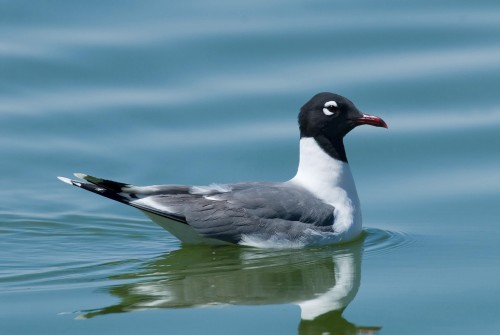| North in the Spring #9 Charlie Lake North by John Neville The Alaska Highway, #97, from Dawson Creek, BC to Fairbanks, Alaska, is just over 2400 km. We turned off at km 79 onto road #271. It led to Beatton Provincial Park on the east side of Charlie Lake. In spring and fall its very popular for birders from southern BC to look for migrating birds. Many years ago we arrived in early spring when the ice had just begun to melt. In the small open leads of water were thousands of swans, geese, ducks and gulls all rafted together. The squeaky calls of Franklin's gull particularly appealed to me. We have enjoyed a summer colony of these gulls at Wembley Marsh, near Grand Prairie Alberta for many years. In the fall you can often see all four loon species on their southerly journey. 
The park is 320 hectares. Aspen is the dominant forest cover with mixed alder, birch, lodge pole pine and spruce. The understory contains Saskatoon berry, Flattop Spirilia and Waxberry. In addition to a campground and day use area there are some excellent forest trails. The camp host recommends July as the best month to fish for Northern Pike and Walleye. I was a little late getting up for the dawn chorus at about 4: 45. The melodic voice of a robin, the "wail" call of a Common loon and the ethereal voice of a Swainson's Thrush were the first sounds to greet me through the open door. The familiar "hey sweetie" of a Black-capped Chickadee and the measured drumming of a Roughed Grouse soon joined the chorus. Then the special sounds of the Boreal Forest started to capture my senses. Charlie Lake is east of the Rockies and therefore is the only part of the province that accommodates eastern boreal species. The loud "teacher-teacher-teacher" song of an Ovenbird, the whistled "oh, canada-canada-canada" of a White-throated sparrow and the "cher-lek" calls of a Least Flycatcher joined in. The descending notes of a Northern Waterthrush, ending in "chew chew" could be heard at the water's edge. The Magnolia Warbler, with his bright yellow and black breast, quietly sang his short musical but rather weak and simple "sweeter sweeter sweetest". The soft 2, 3 and 4 note calls of a Redstart made me smile. Another familiar character announced his presence before I finished my first cup of coffee: it was the two noted raucous calls of a Bluejay. When the sun was a little higher the rich whistled song of a Rose-breasted Grosbeak reached me from the top of a black spruce. On this late spring morning the park was truly vibrant with birdsong . The Alaska Hwy snakes over hills and descends into river valleys and winds between endless, spruce, poplar and aspen trees. The road took us closer and closer to the Northern Rockies on our left hand side. We soon discovered that most of the route was still surrounded by wilderness: "that going to the mountains is going home, that wildness is a necessity and that mountain parks and reservations are useful, not only as fountains of timber and irrigating rivers, but as fountains of life." John Muir. After driving through Wonwon, a pipeline assembly point, we passed a hiker. He was wearing a bright yellow vest, towing a small cart (like a silky) and using walking poles to aid his progress on his northerly migration. He reminded me of two stories: first, "Biking the Alaska Highway" by Arthur W. Peterson, which gives a different prospective of distances, isolation and of course elevations compared with us in a motorhome. Second, "The Book Guy: A Librarian in the Peace" by Howard Overend, who was driving this highway in the 1960's, when it was still gravel, delivering books to tiny communities and schools. This was before BC Nature was born. At km 226 we pulled in for gas at Pink Mountain and a rest. May's Kitchen (once popular with birders) has been replaced by The Buffalo Inn. A generation ago a Buffalo herd escaped from a ranch and are still roaming this area. There is a very rough forest road to the top of Pink Mountain! We did it in a jeep many years ago and observed several disguarded exhaust pipes from low clearance compact cars. My purpose was to record White-tailed Ptarmigan at the beginning of the spring season while there was still a little snow in the alpine zone. Later in the summer it's a great place for alpine flowers. The summit also gives wonderful views of higher Rocky Mountain peaks, like white stepping stones in the sky. Paleontologists also like this area for the fossils. At the edge of the Asininity Chief River a monster reptile was excavated in 1990's. It was called Ichthyosaurus and measured 23 meters! The Royal Tyrell museum are slowly preparing it for display. |